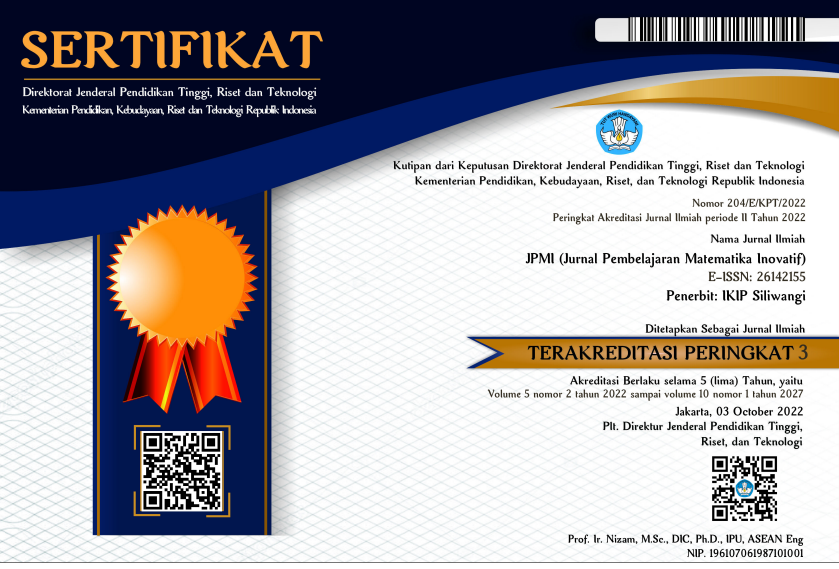Analisis kemampuan pemecahan masalah siswa dalam menyelesaikan masalah non-rutin statistika
DOI:
https://doi.org/10.22460/jpmi.v6i4.17808Keywords:
Problem-Solving Ability, Non-routine problem, StatisticAbstract
References
Andayani, F., & Lathifah, A. N. (2019). Analisis kemampuan pemecahan masalah siswa smp dalam menyelesaikan soal pada materi aritmatika sosial. 3(1), 1–10.
Căprioară, D. (2015). Problem Solving - purpose and means of learning mathematics in school. procedia - social and behavioral sciences, 191, 1859–1864. https://doi.org/10.1016/j.sbspro.2015.04.332
Dogan, E., & Tatsuoka, K. (2008). An international comparison using a diagnostic testing model: Turkish students’ profile of mathematical skills on TIMSS-R. Educational Studies in Mathematics, 68(3), 263–272. https://doi.org/10.1007/s10649-007-9099-8
Fauziah, N. S., & Kurniasih, M. D. (2022). Analisis kemampuan pemecahan masalah pada materi spldv tingkat smp ditinjau pada gaya belajar. 7(2), 113–122.
Harahap, E. R., & Surya, E. (2017). Kemampuan pemecahan masalah matematis siswa kelas vii dalam menyelesaikan persamaan linear satu variabel. 07.
Ä°ncebacak, B. B., & Ersoy, E. (2016). Problem solving skills of secondary school students. China-USA Business Review, 15(6). https://doi.org/10.17265/1537-1514/2016.06.002
Inoue, N., Asada, T., Maeda, N., & Nakamura, S. (2019). Deconstructing teacher expertise for inquiry-based teaching: Looking into consensus building pedagogy in Japanese classrooms. Teaching and Teacher Education, 77, 366–377. https://doi.org/10.1016/j.tate.2018.10.016
Intaros, P., Inprasitha, M., & Srisawadi, N. (2014). Students’ problem solving strategies in problem solving-mathematics classroom. Procedia - Social and Behavioral Sciences, 116, 4119–4123. https://doi.org/10.1016/j.sbspro.2014.01.901
Jumramiatun, Sowanto, & Mikrayanti. (2020). Analisis kesulitan siswa dalam menyelesaikan soal cerita pada pokok bahasan program linear. Jurnal Pendidikan Matematika, 4(2), 45–62.
Maisyaroh Agsya, F., Roza, Y., & Riau, U. (2019). Analisis kemampuan pemecahan masalah ditinjau dari motivasi belajar siswa mts. Symmetry | Pasundan Journal of Research in Mathematics Learning and Education, 4.
Mayangsari, S. N., Liza, D., & Mahardhika, T. (2018). Scaffolding pada penyelesaian soal non rutin telescopic. Dalam Jurnal Ilmiah Edutic (Vol. 4, Nomor 2).
Nur, S. A., & Palobo, M. (2018). Profil kemampuan pemecahan masalah siswa ditinjau dari perbedaan gaya kognitif dan gender. Jurnal Matematika Kreatif Inovatif , 9(2), 1–10.
Putri, D. K., Sulianto, J., Azizah, M., Matematika, P., Penalaran, K., & Masalah, P. (2019). a r t i c l e i n f o. International Journal of Elementary Education, 3(3), 351–357. https://ejournal.undiksha.ac.id/index.php/IJEE
Riskyanti, D., Hamid. Hasan, & Jalal, A. (2021). Analisis kemampuan pemecahan masalah matematis siswa kelas vii-1 smp negeri 14 halmahera selatan pada materi aritmatika sosial. Jurnal Pendidikan Guru Matematika, 1(1), 41–56.
Silvia, S., & Madawistama, T. (2020). Analisis kesalahan peserta didik dalam menyelesaikan soal cerita pemecahan masalah materi sistem persamaan linear dua variabel berdasarkan newman. Journal of Authentic Research on Mathematics Education (JARME, 2(2), 191–200.
Sugiyono. (2012). Metode penelitian kuantitatif, kualitatif, dan R&D (Cetakan Ke-10). Alfabeta .
Zulfah. (2018). Pengaruh penerapan model pembelajran kooperatif tipe think pair share dengan pendekatan heuristik terhadap kemampuan pemecahan masalah matematis siswa mts negeri naumbai kecamatan kampar. Jurnal Cendikia Pendidikan Matematika, 1(2), 1–12.
Zulfitri, H., Aisyah, N., & Indaryanti. (2019). Analisis kemampuan pemecahan masalah matematika setelah pembelajaran dengan pendekatan meas pada materi sistem persamaan linier tiga variabel. Jurnal Gantang, 4(1), 7–13. https://doi.org/10.31629/jg.v4i1.881.

















